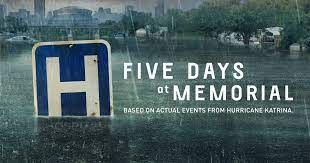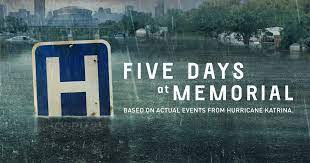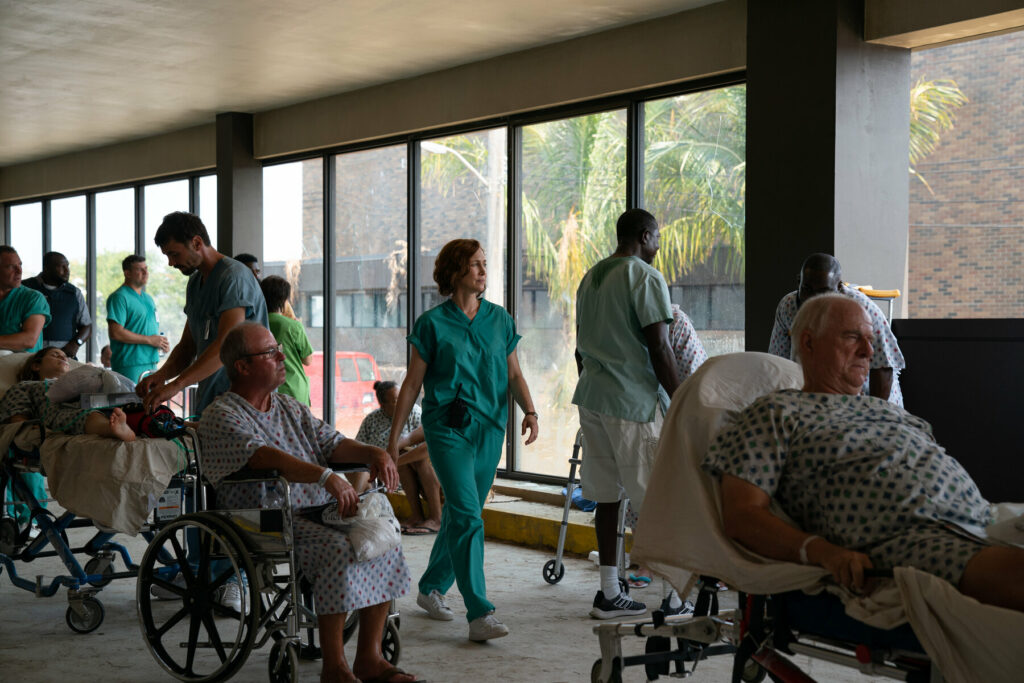
Five Days at Memorial—No Emergency Exit

Five Days at Memorial is an Apple TV+ eight-episode miniseries that premiered on August 22 of this year. Based on the multiple-award winning 2013 book by journalist Sheri Fink, this series revisits the tragic and hellish events that occurred at Memorial Medical Center over five days: August 28 – September 1, 2005—during Hurricane Katrina, in New Orleans, Louisiana.
As floodwaters begin threatening the lower hospital floors at Memorial Medical, electricity is cut off and backup generators fail, temperatures soar to over 100 degrees and food and water become scarce. With no organized rescue plan in place by the administration, the personnel are forced to create their own plan.
In the chaotic aftermath of Hurricane Katrina, Dr. Anna Pou (in a tightly conflicted persona played with perfection by Vera Farmiga) , a well-respected cancer surgeon, finds herself in the eye of the storm. She, along with her colleagues, make impossibly complex life-or-death decisions that will haunt them for years to come.

Thousands of staff, patients and evacuees are trapped inside the building awaiting evacuation by boat or helicopter. Near the end of the five-day crisis, a stoic hospital administrator, Diane Robichaux (the formidable Cherry Jones), under siege, pleads for help from the Tenet Corporation, owner of Memorial Medical, to evacuate more than 180 patients. They promise to send private ambulances, helicopters, and boats so everyone waits. . The local government’s rescue efforts and communications are in chaos. And at the eleventh hour Air Force One flies over New Orleans with President Bush surveying the devastation.
A triage system is hastily put into place. The doctors and hospital administrators quickly agree that babies in the neonatal intensive-care unit, pregnant mothers and critically ill but ambulatory adult I.C.U. patients would be at great risk from the heat and should get first priority. Patients with Do Not Resuscitate orders or those too heavy to lift on a stretcher should go last.
The doctors had now spent days on duty, under duress and sleeplessness. A Memorial nurse announces that the Coast Guard would evacuate some critical patients if they were brought to a long-unused helipad atop an eight-story parking garage, Before climbing up to the pad they first had to climb down five flights of stairs in the dark to street level . Some patients from LifeCare, the hospital unit with the most critical patients requiring ventilators, could not be transported to the helicopters. And hand-held ventilators would soon cease functioning. Patient evacuation begins on the third day and progresses slowly until the fifth day. During those chaotic hours crews of doctors, nurses and family members carried Memorial patients down flights of stairs and wheeled them to the hospital wing where the last working elevator brought them to the ground floor. Each patient was then maneuvered onto a stretcher and passed through a roughly three-by-three-foot opening in the machine-room wall that offered a shortcut to the parking garage. Many patients were placed in the back of a pickup truck, which drove to the top of the garage.
After several Coast Guard helicopters arrive and rescue some of the more fortunate LifeCare patients, they turn their focus on saving people stranded on rooftops around the city. Help was coming too slowly or not at all while too many patients and staff continue to wait and hope. State Police officers wielding shotguns bark, on day five, that everyone has to be out of the hospital by 5 p.m. because of civil unrest. They would not stay later to protect the hospital.
Which patients should get a share of limited resources, and who decides? How, if at all, should doctors and nurses be held accountable for their actions in the most desperate of circumstances, especially when their government fails them? These questions are posed nearly two years after the end of Hurricane Katrina. The bodies of 45 patients are recovered from the makeshift morgue housed in the chapel of Memorial Medical. The state attorney general, as well as families of the deceased pressuring for justice, result in a grand jury and multiple civil lawsuits.
But what message does this send hospital personnel who are in in the middle of a medical disaster? Dr. Pou has made it one of her missions to propose legislation to protect doctors in similar situations.
Five Days at Memorial is a deeply profound, fair and sympathetic depiction of all involved parties in one of the country’s most horrific modern disasters. Full of powerful performances, especially from Farmiga and Jones, the writing and direction create a situation that is simply devastating and almost unbearable to watch. In analogous situations such as Hurricane Sandy in 2012, the lack of preparedness by hospitals and government in response to disasters still reveals epic failure to create and enforce standards for emergencies..
The series starts heavy, has some saggy, slow, and annoying detours, but as the calamities and moral dilemmas mount, it becomes a compelling watch. And the closing is a stunner!
Dr. Anna Pou stands in for all of us: what do we tell ourselves in order to justify our behavior?
Availability: Apple TV+
Note: Five Days at Memorial originated as a 13,000-word magazine article titled “The Deadly Choices at Memorial”, published by The New York Times Magazine in August 2009, the fourth anniversary of Hurricane Katrina. It won the Pulitzer Prize.
Note: The arguments Dr. Pou is making about disaster preparedness deserve closer attention. Medical workers should be virtually immune from prosecution for good-faith work during devastating events and lifesaving interventions, including evacuation. Protocols for making the kind of agonizing decisions that will, no doubt, arise again.
Note: Tenet Health Systems, which operated Memorial Medical Center in New Orleans, settled claims brought by Hurricane Katrina victims for $25 million. The victims’ claims entailed negligence not only for Tenet’s failure to respond, but also for its failure to plan and prepare properly for the emergency itself . Legislation S.3721 – Post-Katrina Emergency Management Reform Act of 2006—sponsored by Senator Susan Collins, passed unanimously, and protects medical workers in cases of national disaster, similar to protection for military personnel grappling under emergency conditions.

Joseph A.
I was undecided about watching this series. Your review has convinced me that it will be worthwhile. Thanks. On a lighter side, the Bad Sisters series from Ireland is definitely worth watching on Apple TV+.
Diana Paul
I’m ready to review Bad Sisters as soon as the finale is released!